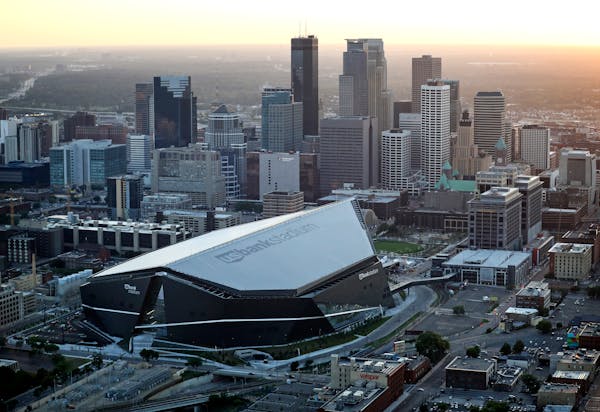Now that Minnesota lawmakers appear warm to the idea of paying off taxpayer construction loans on U.S. Bank Stadium, the city of Minneapolis wants in on that action.
Thanks to flush state coffers, Gov. Tim Walz supports forgiving a portion — some $60 million — of the city's obligations to the state as part of his proposed budget, which includes paying off all the taxpayer debt on the stadium more than 20 years early.
But that plan wouldn't zero out all of Minneapolis' obligations to the home of the Vikings. Most notably, the city would still be on the hook for annual payments to the state through 2046 that would ultimately total around $333 million, according to city and state finance records.
The city wants that wiped out as well.
"We're talking about a state asset," Mayor Jacob Frey said in an interview. "Minneapolis is part of the state. What happens in Minneapolis impacts every portion of the state. This is a smart financial move for the state of Minnesota, and we're part of that. If the debt is fully prepaid, Minneapolis' portion should be as well."
The political prospects of the city's hopes are unclear.
Walz's plan to pay off the debt is about as straightforward as the state cutting a check. But clearing the city's ledger on its portion of the construction cost is more complicated. It would require a change in the state laws that enabled the stadium to be built seven years ago.
On the other hand, giving Minneapolis what it's asking for would not require the state actually spending any more money; instead, the state would be giving up a source of revenue: annual payments from Minneapolis into the state's general fund.
Original stadium deal
Back when the stadium was approved, the grand compromise — it was bipartisan, bicameral and included the city and the Vikings — split the cost of building the stadium almost equally between the private and public sectors, with the private sector picking up 55% and the public 45%. The city and state split the latter, with the city agreeing to pony up 30% and the state 70%.
When the final construction tab came in at roughly $1.1 billion, that left the Vikings and additional private sources ponying up about $620 million, the state owing about $350 million and the city of Minneapolis — where the stadium is located — committed to around $150 million.
Important note: Those dollar amounts are from the original price tag. Paying that money meant taking out long-term loans, which meant interest, which meant the final amount paid would be significantly more — bringing the total to around $880 million from the public sector.
Avoiding much of that interest accruing is one of the reasons why paying off the stadium early has garnered bipartisan support; it would save taxpayers about $226 million.
Another reason: There's a big pile of cash to do it.
Pile of cash
Under Walz's plan, which was first floated by lawmakers from both parties last year, the vast majority of the payoff would come from the stadium reserve fund. The fund is brimming with money as its source, electronic pulltabs, grew in popularity since they were approved as part of the original stadium plan.
That, combined with a projected record surplus in the state's general fund, has created fertile ground for paying down the stadium debt, which stands at $377 million. Here are the projected numbers: The stadium reserve fund will have about $368 million, and the general fund will have a surplus of about $17.6 billion.
Minneapolis, meanwhile, has seen its funding sources for stadium debt payments — a mix of local hospitality and sales taxes — strained since the pandemic began.
The city has just begun to make payments on its obligations for stadium costs. From 2016 to 2020, the state essentially covered for the city's payments to allow the city to pay off debt from the Minneapolis Convention Center. It's those payments that Walz has proposed to forgive, amounting to a roughly $60 million savings for the city.
Lobbying begins
The city's side of stadium financing is a complex series of commitments to different aspects of the stadium, and those supporting the city's position will have to convince lawmakers that they're not trying to freeload off the state's current largesse.
The city's argument to lawmakers is that if the public debt does get paid off early — as Walz has proposed and lawmakers from both parties seem enthusiastic about — the city shouldn't have to make any payments to the state over that debt. But it's unclear how that will play with lawmakers, since the original law was drafted so that the city would have to make payments regardless.
State Sen. Nick Frentz, DFL-Mankato, the lead sponsor of one stadium debt bill already introduced at the Capitol, was non-committal when asked whether he supported the city being relieved of its future construction payments.
"I'm confident that if the House, Senate and governor work together, we can get the best result for the state of Minnesota," he said in an interview, noting that many lawmakers have just begun learning the intricacies of the issue.
The city has other obligations to the stadium, which it shares with the Vikings, including annual payments to a fund for operating expenses and to another fund for capital improvements.
Those payments and how they're calculated could serve as bargaining chips in negotiations between the city and any skeptical lawmakers.
It's also possible the issue could become tied up in larger talks about the state's overall two-year budget, which often isn't hammered out until May.
8 months in jail for Blaine man who caused 120-mph crash hours after he was caught speeding

Daughter sues St. Paul, two officers in Yia Xiong's killing

